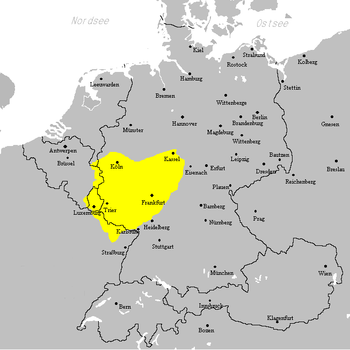- West Central German
-
West Central German Geographic
distribution:Rhineland-Palatinate, Saarland, Hesse, North Rhine-Westphalia, Lorraine, Deitscherei Linguistic classification: Indo-European - Germanic
- West Germanic
- High German
- Central German
- West Central German
- Central German
- High German
- West Germanic
Subdivisions: —
West Central German–language areaWest Central German belongs to the Central, High German dialect family in the German language. Its dialects are thoroughly Franconian including the following sub-families:
- Central Franconian (Mittelfränkisch)
- Ripuarian Franconian (Ripuarisch) (North Rhine-Westphalia, Rhineland-Palatinate and Belgium)
- Luxembourgish (Lëtzebuergesch, Luxembourgeois) (Luxembourg, Belgium and France)
- Moselle Franconian (Moselfränkische, Francique mosellan) (North Rhine-Westphalia, Rhineland-Palatinate, Saarland and France)
- Rhine Franconian (Rheinfränkisch) (including Palatinate German, Rhineland-Palatinate and Saarland)
- Lorraine Franconian (Francique rhénan) (France)
- North Hessian (Nordhessisch)
- Central Hessian (Mittelhessisch)
- East Hessian (Osthessisch)
- Bukovina German (Bukowinadeutsche) (extinct)
- Pennsylvania German (historical communities in North America, especially Pennsylvania)
Apart from West Central German on the southern edge and in south-east Franconian dialects are turning to Upper German. This transition area between Central German and Upper German is captured by the dialect families of South Franconian German and East Franconian German, colloquially miscalled Franconian as dialects of this sub-family are spoken all over Franconia.
West Central German was spoken in several settlements throughout America, for example in the Amana Colonies.
See also
- East Central German
- Limburgish language
- High German consonant shift
- Germanic
Wikimedia Foundation. 2010.

